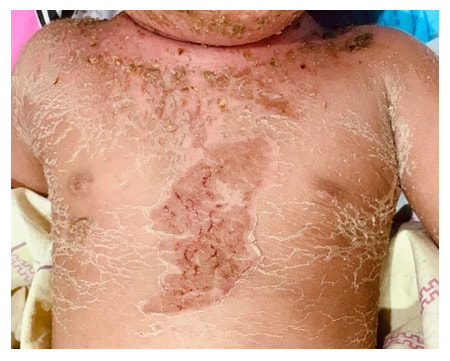

Staphylococcal scalded skin syndrome (SSSS) is a potentially serious exfoliating condition occurring predominantly in children, particularly neonates.
CAUSE:
It is caused by systemic circulation of epidermolytic toxins from a Staph. aureus infection. The same toxins are implicated in bullous impetigo, which is a localized form of SSSS.
CLINICAL FEATURES:
The focus of infection may be minor skin trauma, the umbilicus, urinary tract or nasopharynx. The child presents with fever, irritability and skin tenderness. Erythema usually begins in the groin, axillae and around the mouth. Blisters and superficial erosions develop over 1–2 days and can rapidly involve large areas, with severe systemic upset. Bacterial swabs should be obtained from possible primary sites of infection. A skin snip should also be taken for urgent histology. This is a sample of the superficial peeling skin removed by ‘snipping with scissors’, without the need for local anaesthetic. It shows a split beneath the stratum corneum, and differentiates SSSS from toxic epidermal necrolysis, in which the whole epidermis is affected.
MANAGEMENT:
Bacterial swabs from nostrils, axillae and groins should be taken from family members to exclude staphylococcal carriage. Although the acute presentation of SSSS is often severe, rapid recovery and absence of scarring are usual, as the epidermal split is superficial.
HOMOEOPATHIC TREATMENT:
Homoeopathy today is a rapidly growing system and is being practiced all over the world. It strength lies in its evident effectiveness as it takes a holistic approach towards the sick individual through promotion of inner balance at mental, emotional, spiritual and physical levels. When is concerned there are many effective medicines available in Homoeopathy, but the selection depends STAPHYLOCACCAL SCALDED SKIN SYNDROME upon the individuality of the patient, considering mental and physical symptoms.
CARBOLIC ACID: - Itching vesicles, with burning pain. Burns tend to ulcerate. Offensive odour from skin. Erysipelas; violet color swelling, roughness.
PYROGEN: Skin pale, cold, of ashy hue. Obstinate, varicose, offensive ulcers of old people. -Cannot lie more than few minutes in one position, change. Debility in morning, staggered on trying to walk, Nervous, restless, aching all over, bed feels hard, Great muscular debility, rapid recovery in few hours.
RHUS TOXICODENDRON: Exanthema in general, burning, burning itching, pustulous, with swelling; blotches; like milk-crust; moist, like nettle-rash, blue with erysipelas, scurfy, tensive or tight feeling in, pock-shaped, black, purulent, zona or shingles, Petechiae, prickling, tickling, blisters which will sometimes spread up the limb, and are sometimes circular in form, spreading with a red edge in the advance, which gradually turns to a blister, the red border still keeping in advance itching after scratching. Tetters in general. Ulcers burning; with corroding pus; with ichorous pus. Phlegmonous erysipelas, esp. where the erysipelas begins in the ankle, and moves gradually up the leg, running up in the deeper tissues, no fever. Itching over whole body, chiefly in hairy parts. Stinging and tingling on skin, burning after scratching.
ARSENICUM ALBUM: Desquamation of the skin of the body. Skin dry as parchment, cold and bluish. Yellowish colour of the skin. Shootings, hot itching, and violent burning in the skin. Reddish or bluish spots in the skin. Petechiae. Inflamed spots, as from morbilli, chiefly in the head, face, and neck